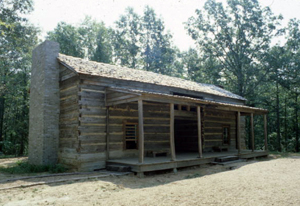Listed in Arkansas Register of Historic Places on 09/03/97
SUMMARY
The Wylds Cabin is being nominated to the Arkansas Register of Historic Places under Criterion C with local significance. Antebellum structures are rare and the Wylds Cabin is an unusual example because of its size and construction. The cabin was altered through the addition of a brick exterior chimney and front and rear porches after it was moved from its original location. It is not being considered for listing in the National Register of Historic Places at this time due to the possibility that the structure will be relocated again in the near future.
ELABORATION
David Wylds, a pioneer from Georgia, traveled to Arkansas to hunt bears in 1821. He had received a land grant of 160 acres in return for service to his country as an orderly sergeant in the War of 1812. Mr. Wylds settled in what is now St. Francis County near the community of Tuni in 1821. The area, not yet a state, was covered with virgin timber and wild game and was still populated by Indians. His original home was a small one-room cabin on Crowley’s Ridge where he lived with his wife, Mary, and his growing family until he completed a larger home below the Ridge in 1843. When the new house was built, Mr. Wylds had eight children and a productive farm.
David Wylds died in 1858 but his son, Dan, continued to farm the original homestead and saw it grow to 1,813 acres. At the time of his marriage Dan built a home of his own on the Ridge. He built a larger home in 1887, also on the Ridge, to accommodate the addition of four children. Dan's son Rodney inherited the farmstead and tore down his father's house in 1946, using some of the lumber in the construction of a new home. The remodeled home was later sold out of the family and covered in brick veneer.
Wylds family members and friends continued to live in the cabin, but by 1976 the house had been unoccupied for several years and seemed in danger of collapsing. A local planter and businessman, Dr. O. P. Hammons, noticed the home and its sad condition. Afterward, Dr. Hammons went to work to garner support from the St. Francis Historical Society and the East Arkansas Community College for preservation of the Wylds home. Rodney Wylds' widow, Mrs. Mattie Wylds was persuaded to sell the home and one acre of land to the Historical Society. Dr. Hammons then consulted the college board on arrangements for the East Arkansas Community College to accept the cabin as a gift from the Historical Society.
BIBLIOGRAPHY
Hammons, Dr. E.P. "Narrative on the Significance of Placing the Wylds Log Cabin on the National Register of Historic Places."
Crowley Ridge Chronicle, Forrest City, Arkansas. 1978.
Crowley Ridge Chronicle, Forrest City, Arkansas. 1976.
Times-Herald, Forrest City, Arkansas. 1978.
Times-Herald, Forrest City, Arkansas. 1976.
Star Herald, Hughes, Arkansas. 1978.
The Goodspeed Biographical and Historical Memoirs of Eastern Arkansas. Chicago, Nashville, and St. Louis: The Goodspeed Publishing Co., 1890. P. 505.
